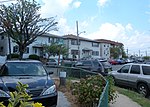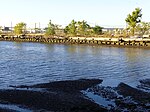Roosevelt Stadium
1937 establishments in New Jersey1985 disestablishments in New JerseyArt Deco architecture in New JerseyBaseball venues in New JerseyBrooklyn Dodgers stadiums ... and 10 more
Buildings and structures in Jersey City, New JerseyCulture of Jersey City, New JerseyDefunct Major League Baseball venuesDefunct baseball venues in the United StatesDefunct minor league baseball venuesDemolished sports venues in New JerseySports in Hudson County, New JerseySports venues completed in 1937Sports venues demolished in 1985Works Progress Administration in New Jersey

Roosevelt Stadium was a baseball stadium at Droyer's Point in Jersey City, New Jersey. It opened in April 1937 and hosted high-minor league baseball, 15 major league baseball games, plus championship boxing matches, top-name musical acts, an annual championship drum and bugle corps competition known as "The Dream" Held 1946–1983, important regional high school football and even soccer matches. It was demolished in 1985.
Excerpt from the Wikipedia article Roosevelt Stadium (License: CC BY-SA 3.0, Authors, Images).Roosevelt Stadium
Cottonwood Street, Jersey City
Geographical coordinates (GPS) Address Nearby Places Show on map
Geographical coordinates (GPS)
| Latitude | Longitude |
|---|---|
| N 40.706388888889 ° | E -74.105 ° |
Address
Cottonwood Street 62
07305 Jersey City
New Jersey, United States
Open on Google Maps









